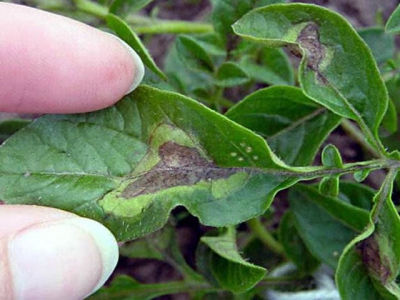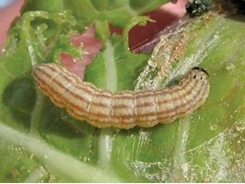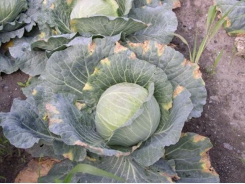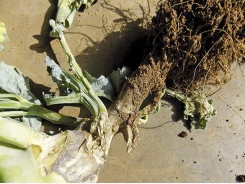Common Diseases of Greenhouse Plants

1/ Damping off
Various fungi and bacteria, Pythium sp., Phytophthora, and others which are common in garden soils contribute to this problem. Seedlings topple and die, often in circular patches; the stems sometimes shrivel or discolour near soil level. Seedlings of bedding plants such as antirrhinums, lobelia, and petunias are particularly susceptible, although many others are often affected. The problem is worse in damp, cold, overcrowded conditions.
Prevention
Clean pots and seed trays thoroughly. Use a good seed compost: one which drains well and is free from disease organisms. Sow thinly, and give seeds sufficient warmth and ventilation. Do not water susceptible seedlings from water-butts.
Treatment
None. Dispose of infected seedlings and do not re-use contaminated seed compost.
2/ Downy mildew
This is an off-white mould occurring in cool damp conditions, caused by Peronospora and Bremia fungi. Winter lettuce is the plant most commonly affected in greenhouses; pale patches appear on the surfaces of leaves with corresponding patches of mould on the under-sides. Resting bodies of the fungus can survive in the soil and crop debris.
Prevention
Avoid overcrowding plants, and ventilate the greenhouse well. Do not grow susceptible plants at low temperatures. Good hygiene is essential, particularly picking off dead or damaged flowers and leaves. A few varieties of lettuce and strawberries have some resistance.
Treatment
Remove and destroy affected leaves immediately.
3/ Powdery mildew
This is a powdery white coating, caused by Sphaerotheca, Oidium, Uncinula, and other fungi, which can cover almost any part of the plant. Susceptible greenhouse plants include cucumbers, strawberries, vines, and chrysanthemums However, the disease will not spread between them, for example from cucumbers to vines, as there are many different powdery mildew fungi each with a limited range of host plants. All powdery mildews are worse in hot, dry, overcrowded conditions. Their spores spread in the air, and usually overwinter on crop debris.
Prevention
Ensure adequate ventilation. Do not overcrowd plants, and keep them well watered. Clear out all plant debris at the end of the season. Look out for resistant cucumber varieties.
Treatment
A spray of bicarbonate of soda solution has been used to control many powdery mildews. Sulphur is a traditional organic remedy, but many greenhouse plants are damaged by this chemical.
Prevention
Rotate lettuce crops or change border soil. Ventilate the greenhouse well. Do not let seedlings or plants get overcrowded and keep water off the leaves. Look out for resistant varieties.
Treatment
Remove infected leaves as they appear and clear out plants and debris after harvest.
4/ Grey mould
A distinctive fluffy grey mould, Botrytis cinerea, affects many greenhouse plants. For example, it commonly develops on the leaves and fruit of cucumbers, beans, lettuces, tomatoes, strawberries, and vines, and on the flowers of chrysanthemums. The fungus exists widely on dead or dying plant material and spreads by spores which are often released in clouds when the mould is touched. Infection is worse in cool, damp, overcrowded conditions.
5/ Potato and tomato blight
The spores of this widespread potato disease (Phytophthora infestans) can be blown into the greenhouse in warm humid weather and infect tomato crops. It causes dark blotches on the leaves, sometimes with a white mould on the under-sides, and a dryish brown rot on the fruit.
Prevention
Take precautions to avoid blight on your potato crops, and remove any infected potato foliage.
Treatment
There is no cure.
6/ Root and foot rots
Symptoms of wilted leaves and blackened or decayed roots can be caused by a wide variety of fungi. They are nearly all soil- and water-borne, and ways of avoiding them and treating them are the same. Susceptible greenhouse plants include cucumbers, lettuces, strawberries, tomatoes, chrysanthemums, and primulas. Plants under stress are more susceptible.
Prevention
Keep plants growing strongly. Do not use unsterilized soil in potting compost or reuse old potting compost if either is likely to be contaminated. Rotate crops in borders or change the soil regularly. Scrub out water-butts.
Treatment
None. Remove and destroy infected plants.
7/ Viral Diseases of Greenhouse Plants
There are many viruses which affect greenhouse plants, often causing symptoms such as stunted and/or distorted growth, mottling of the leaves, and streaked flowers. These symptoms are easily confused with those caused by deficiencies and disorders. Viral diseases can be spread from plant to plant in a number of ways: by aphids and other sap-sucking insects; by contact with infected foliage, tools or hands; in the soil; or sometimes in seed. A few common examples are given here, but the methods of prevention and treatment are similar for them all.
Prevention
Never take cuttings or save seed from diseased plants. Use resistant varieties if available. Control creatures such as aphids that may pass on the virus. Remove weeds and clear old plants as soon as harvesting is over.
Treatment
None. Remove the infected plants completely and avoid contaminating healthy plants from hands, pots, tools, etc.
8/ Cucumber mosaic virus
Mosaic patterning forms on leaves of cucumbers and courgettes, and sometimes fruit becomes distorted. Other plants commonly affected include lettuces, tomatoes, begonias, and Primula, and the virus is also carried by chickweed (Stellaria media). It is transmitted mainly by aphids, but also by contact and possibly by seed. Look out for resistant varieties.
Tobacco mosaic virus
This causes leaf mottling and often wilting of young tomato leaves. Some (but not all) leaves may also become puckered or dwarfed. Brown patches develop beneath the surface of green fruit. The virus also affects Nicotiana, peppers, petunias, and potatoes, and can be carried in tobacco. It is very infectious, and is spread by contact and seeds but not by aphids. Look out for resistant varieties of tomatoes and peppers.
Tomato aspermy virus
This is common on chrysanthemums, causing small ragged blooms, and will also infect tomatoes, which become bushy with mottled leaves and small fruit. It is spread by aphids.
9/ Wilts
Most wilts on greenhouse plants are caused by Verticillium or Fusarium fungi. The plants lower leaves are the first to wilt, and later they yellow and shrivel. There is a characteristic brown stain in the stem when it is cut well above ground level. Cucumbers, courgettes, French beans, tomatoes, strawberries, begonias, chrysanthemums, and fuchsias are amongst the most susceptible greenhouse plants. The disease can persist in the soil for several years.
Prevention
Do not raise plants too early, or plant them out into cold soil or compost. Rotate crops or change the border soil regularly.
Treatment
Plants not severely infected may recover if given warmer, shadier conditions; earth the stems up with fresh compost or leaf mould. Remove and destroy infected plants and potting compost. Change border soil. Thoroughly wash pots and any contaminated tools, etc. Look out for resistant varieties of tomato.
Tools

Phối trộn thức ăn chăn nuôi

Pha dung dịch thủy canh

Định mức cho tôm ăn

Phối trộn phân bón NPK

Xác định tỷ lệ tôm sống

Chuyển đổi đơn vị phân bón

Xác định công suất sục khí

Chuyển đổi đơn vị tôm

Tính diện tích nhà kính

Tính thể tích ao









 Planning a Garden Greenhouse for…
Planning a Garden Greenhouse for…  Preventing blackleg in cabbage
Preventing blackleg in cabbage